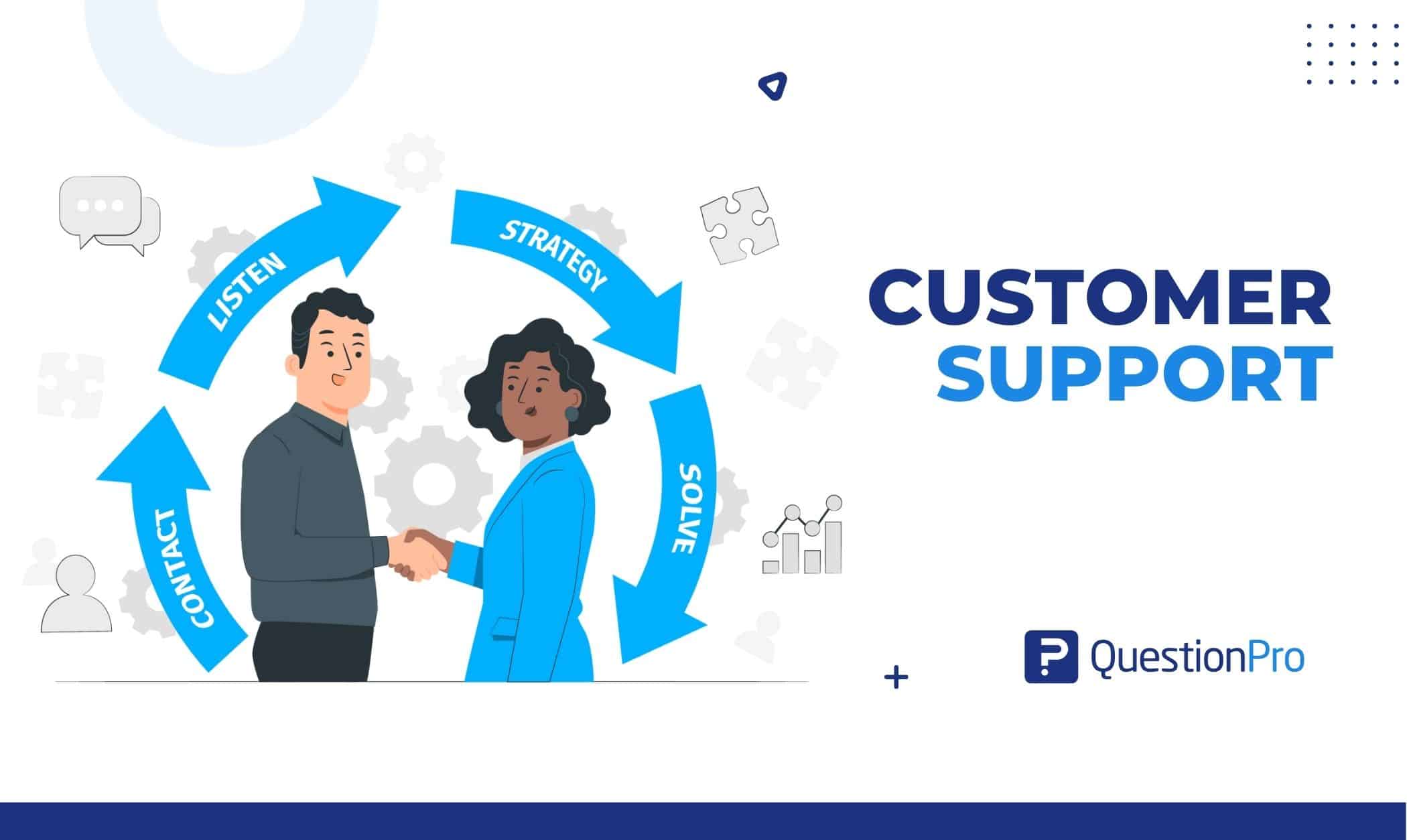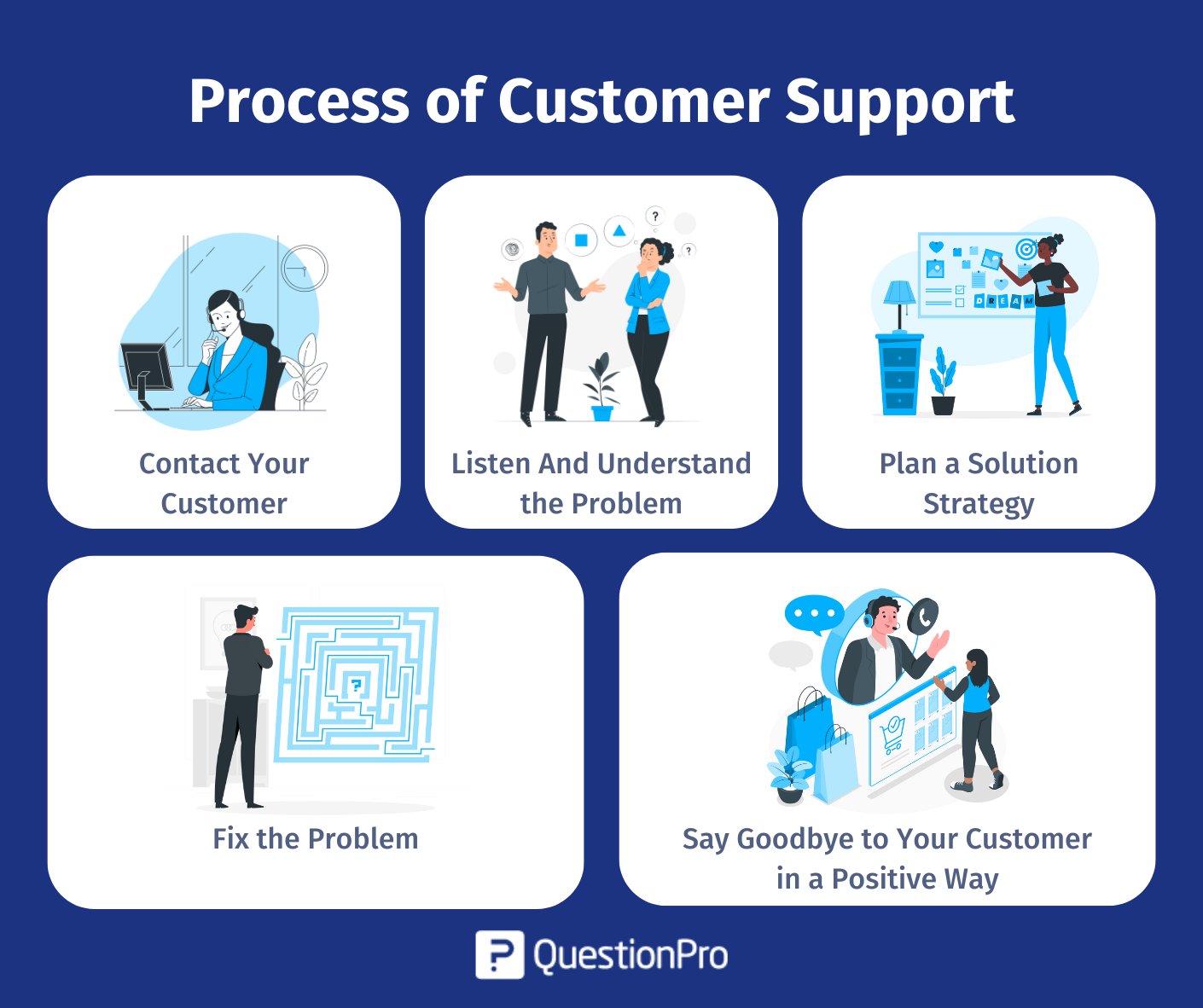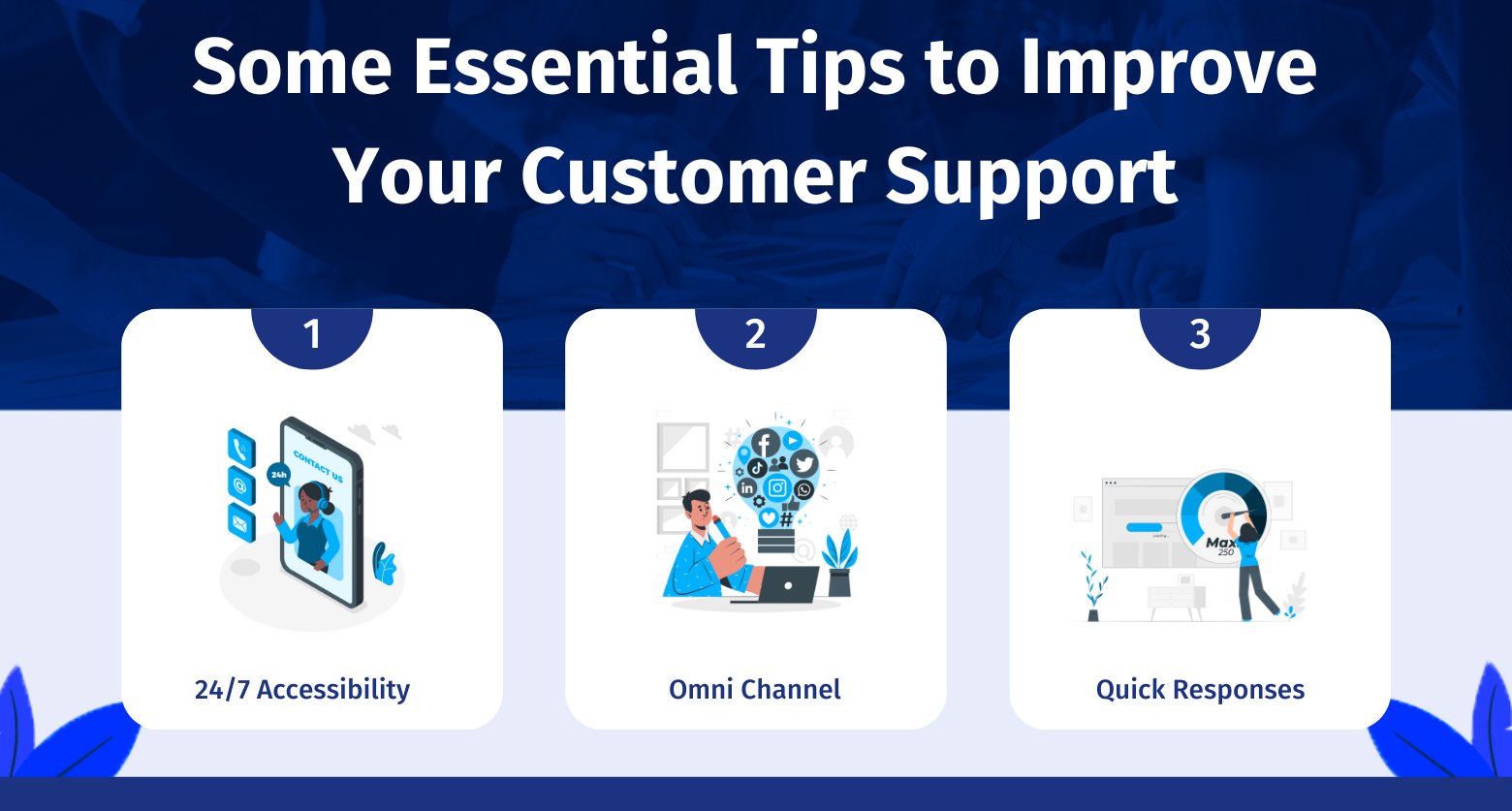
Customer service is changing every day. Modern customer support is more precise than traditional one. It is no longer a separate part of a business. It is now an important part of the business and the company’s overall culture.
Companies are investing more in customer service as part of their products and services to gain a competitive advantage that is hard to imitate.
Client support is no longer just about managing tickets, answering emails, or taking calls. In this age of online communication, customer service is a way for businesses to get to know their customers personally.
In this blog, we will learn what customer support is, its importance, the process, and some key tips for your business in this blog.
What is Customer Support?
Customer support helps its customers when they have questions, issues or need assistance with a product or service. It’s all about making sure customers feel heard and taken care of. It can be answering questions, troubleshooting problems, or guiding them through a process. Good customer support aims to make the customer’s experience smooth and satisfying. It can be done through various customer support channels, like:
- Phone calls
- Emails
- Live chat
- Social media
Ultimately, it’s about building trust and maintaining strong relationships with customers by being responsive and helpful.
The main goal of customer service is to help customers get started and solve their everyday problems during the first contact. It saves customers time and helps them learn about new features or products while promoting better customer satisfaction.
A good support representative understands and is technically knowledgeable about the company’s product and service portfolio. The client support team should also have great listening and talking skills since customer support requires patience, clarity, and brevity.
Importance and Benefits of Customer Support
Customer support is the direct link between your customers and your company. It keeps customers and gets more value out of them. Now, we will discuss why customer service is important for your business:
- Customer or client support is important to any business because it helps build customer trust and customer loyalty. It is essential in our digital age when people expect quick and easy service. When a customer has an issue or a query, they want to know that someone is there to assist them in resolving it.
- A robust customer support system can help a business stand out from competitors by showing that it values customer service. It can also help a business keep customers because happy customers are more likely to stick with the company.
- The service can offer insightful feedback about a company’s products or services. It can help a company figure out what problems or issues its customers are facing and solve them. It can improve the overall customer experience and lead to more sales.
Overall, customer support is important because it can build customer trust and loyalty, improve customer experience, and make a business successful.
Process of Customer Support
The customer support process is the sum of everything that needs to be done to help customers. There are different steps, starting with when a customer calls an agent, gathering information, and ending with giving help.
Here, we will explore the process of customer service with some key steps:

Step 01: Contact Your Customer
The first step in customer support is when the customer reaches out for help. This can be through a phone call, email, chat, or other ways. This contact is what starts the whole process. It’s important that the company makes it easy for customers to reach them. Without this step, the company wouldn’t even know there’s an issue to solve!
Step 02: Listen And Understand the Problem
Once a customer reaches out, it’s time for the customer support teams to listen carefully. The customer usually explains a problem or asks for help. So it’s important to let them talk and collect all the details. Listening closely is important because it helps the customer service teams understand exactly what the issue is. If the agent listens well, they can figure out the best way to help the customer. For example:
“A customer calls to report an unexpected charge on their account. By actively listening, the support agent gathers details about the billing cycle, the customer’s account history, and the specific charge in question. After fully understanding the problem, the agent discovers a duplicate charge, promptly removes it, and explains the solution to the customer.”
Step 03: Plan a Solution Strategy
After the customer has explained their issue, the next step is for the support agent to come up with a solution strategy. This step is all about thinking of the best solution based on what the customer has said. The agent might need to consult with others, use their knowledge, or check resources to make sure they have a solid plan for solving the problem.
According to the previous customer query, a possible solution strategy can be a billing error. In the case of a billing discrepancy, the agent would review the customer’s billing history, confirm the charge’s nature, and consult the billing department if needed.
Once the plan is in place, the agent should clearly communicate the steps to the customer to solve the problem. Finally, following up to confirm the issue is resolved is key to closing the loop and ensuring customer satisfaction.
Step 04: Fix the Problem
Now is the time to take action and fix the issues. This could include:
- Correcting a technical issue
- Walking the consumer through a process
- Providing a replacement or refund
The agent reviews the solution they came up with to fix the problem. It is also critical to keep the customer updated throughout this process so they can understand what is going on and when the problem will be resolved.
Step 05: Say Goodbye to Your Customer in a Positive Way
When the problem is solved, the final step is to say farewell in a positive way. The customer service team should thank the customer for their patience. Leaving a good, lasting impression is key to making the customer happy, and it ensures they feel good about the company, even after dealing with a problem. A simple thank you can go a long way in building customer loyalty.
Are you curious to learn about Customer Care vs Customer Service? Explore QuestionPro to explore!
How to Create a Customer Support Team?
Your support team will be the face of your company whenever customers need help. So you want to make sure you get it right. Here’s how you can create a strong customer support team, step by step:
1. Define the Purpose of the Team
Start by understanding what you need the customer support team to do. The purposes of a customer support team are various according to the customer’s needs. Some of these are given below:
- The main purpose of a customer support team is to ensure customer satisfaction.
- The team is also responsible for building strong relationships with customers.
- The support team should gather feedback to help improve products or services and provide valuable insights to other departments.
- Another key purpose is to reduce response times and maintain a high level of professionalism in every interaction.
2. Hire the Right People
You need to hire the right people to have a successful support team. You need individuals who are patient, good listeners, and great at solving problems. Look for people who have strong communication skills and can stay calm under pressure.
3. Provide Proper Training
Once you’ve hired the right team members, the next step is training. Your support team needs to know everything about your product or service, such as:
- How to use the tools for customer support, such as phone systems or live chat software.
- How to handle common customer issues.
Ongoing training is just as important as the initial setup because customer needs can change, and so can your business.
4. Equip Them with the Right Tools
Your customer support team needs tools to do their job well. This could be helpdesk software to track customer inquiries, communication tools like email and live chat, and even knowledge bases where they can quickly find answers to common questions.
5. Create Clear Processes
Having clear processes in place is essential for keeping your team organized. Make sure everyone knows how to handle different types of customer requests, how to escalate issues to the right people, and how to follow up.
This will prevent confusion and make sure every customer gets the help they need in a timely manner.
6. Create Team Communication
Communication is key for your support team to work smoothly. Encourage your team members to share information with each other, like tips for handling difficult customers or solutions to common problems. Hold regular team meetings to keep everyone on the same page and to discuss any challenges they might be facing.
7. Measure Performance
It’s important to track how your support team is doing. Look at metrics like response time, resolution time, and customer satisfaction ratings. This will help you understand what’s working and where there’s room for improvement.
8. Create a Positive Work Environment
Customer support can be stressful, so it’s important to create a supportive and positive work environment. Recognize your team’s hard work, celebrate wins, and provide opportunities for growth. A happy team will deliver better service to your customers.
Some Essential Tips to Improve Your Customer Support
Customer support aims to make customers’ lives easier. It exists to make sure that everyone gets the best customer service possible. Its main purpose is to solve problems so that customers can use a product or service quickly and get the most out of doing business with a brand.
Some of the best tips for customer service are:

24/7 Accessibility
Support is never a shift-based job. Whether you are open or your store is closed for the day, support must always be available. After all, customers require service 24 hours a day, seven days a week, and you cannot avoid it with today’s technology.
Omni Channel
Customers love to have different ways to connect with a company. An omnichannel customer experience offers multiple support channels, like phone, email, live chat, social media, or even in-person support. By giving customers these options, you make it easier for them to reach out for help in a way that feels comfortable for them.
Planning an effective omnichannel strategy ensures that customers receive the same high-quality support no matter how they choose to engage.
Quick Responses And a Proactive Approach
Customers want quick and easy service. It is important to answer questions and requests as soon as possible. It can be done in several ways, like through email, the phone, or social media. Also, identify and meet your customers’ needs before they arise as problems. Proactively ensuring value when it’s needed enables a business to succeed. It may involve giving customers access to tools or knowledge that allows them to avoid common problems or difficulties.
How Can You Use QuestionPro to Improve Customer Support?
QuestionPro survey software can be a powerful tool for enhancing customer support by enabling businesses to gather, analyze, and act on customer feedback effectively. Here are several ways you can use QuestionPro to improve your customer support:
- Create Customer Satisfaction Surveys: QuestionPro allows you to design and distribute surveys specifically focused on measuring customer satisfaction (CSAT) after support interactions. You can also use a customer satisfaction survey template to make it fast. This feedback helps you understand how customers perceive your service quality.
- Implement Net Promoter Score (NPS) Surveys and Customer Effort Score Surveys: You can use NPS surveys to measure customer loyalty and willingness to recommend your services. Analyzing NPS data can help you identify brand advocates as well as areas needing improvement.
- Gather Feedback on Support Tools: Collect customer insights about their experiences with multiple support channels, such as phone, live chat, email, etc. This information can guide you in optimizing these tools for better service.
- Identify Common Issues and Trends: Use QuestionPro’s analytics features to analyze responses and find common pain points or issues customers frequently encounter. This helps prioritize areas for improvement.
- Monitor Team Performance: You can develop performance surveys for your support agents to evaluate their effectiveness in resolving issues.
- Automate Feedback Collection: You can set up automated surveys for customers after each support interaction. This will ensure you timely feedback collection without adding extra work for your team.
Conclusion
Excellent customer support is important to ensure customers have a good experience with a company or product. You can achieve this by providing precise and accurate information, responding quickly to customer inquiries and complaints, and offering helpful solutions.
Effective customer support helps establish customer trust and loyalty and also contributes to a company’s overall success. Companies must regularly analyze and enhance their client support processes to satisfy customer wants and expectations.
Now, it’s time to improve your client support. To do this, you need to know what your customers think about your product or service and their pain points when connecting with your support team.
QuestionPro is a complete survey platform that can help you better understand your customers. It can also help you figure out where your customer service is lacking and take steps to improve it.
Overall, surveys can be a great way for businesses to improve their customer service by getting feedback, identifying areas for improvement, and measuring customer satisfaction. Try QuestionPro today!
Frequently Asked Questions (FAQs)
While both terms are often used interchangeably, customer support usually refers to the technical assistance provided to resolve issues or answer questions about a product or service. Customer service is broader and focuses on ensuring customer satisfaction at every stage of their experience, from purchasing to follow-up.
a. To improve customer support, you can:
b. Offer multiple channels for support (e.g., phone, email, chat).
c. Provide training for your support team to enhance their skills and product knowledge.
d. Implement self-service options like FAQs or tutorials to reduce waiting times.
A good customer support agent should have:
Strong communication skills: To clearly explain solutions and listen to customer concerns.
Empathy: To understand and relate to the customer’s problems.
Problem-solving ability: To quickly assess and resolve issues.
Patience: To handle difficult situations calmly and professionally.
Product knowledge: To offer accurate and helpful guidance.







